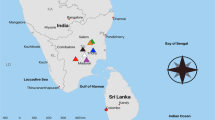Abstract
Large amounts of halophilic organisms and their fossils that are found in the Barkol mirabilite deposit are identical to those of its modern biological community residing in its surface brines.
The extent of investigation to which organisms contributed to the mirabilite mineralization in the Barkol Lake demonstrates that the genetic mechanism of this type of ore deposit is better explained by biochemical deposition than by the widely accepted, purely chemical deposition which, though approved by classical geologists, will certainly be revised in the future.
Similar content being viewed by others
References
GWYNN, J.W. (ed.), 1980, Great Salt Lake A Scientific, Historical, and Economic Overview, p. 305–309.
HAY, R.W., 1984, Bio-inorganic chemistry. Ellis Horwood Ltd. Great Britain, p. 75–89.
ZHENG MIANPING, XIANG JUN, WEI XIN JUN, and ZHENG YUAN, 1989, Saline Lakes on the Qinghai-Xizang (Tibet) plateau (in Chinese). Science and technology press, Beijing, p. 366–369.
Author information
Authors and Affiliations
Rights and permissions
About this article
Cite this article
Dongyan, W., Zhenmin, L., Xiaolin, D. et al. Biomineralization of mirabilite deposits of Barkol Lake, China. Carbonates Evaporites 13, 86–89 (1998). https://doi.org/10.1007/BF03175437
Received:
Accepted:
Published:
Issue Date:
DOI: https://doi.org/10.1007/BF03175437




